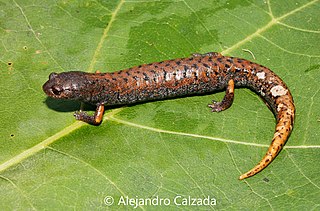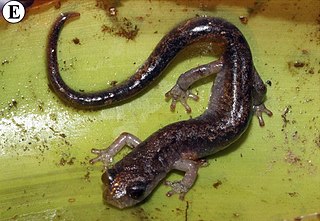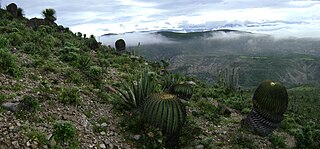
Scincella is a genus of lizards in the skink family, Scincidae, commonly referred to as ground skinks. The exact number of species in the genus is unclear, as taxonomic reclassification is ongoing, and sources vary widely. Scincella species primarily range throughout the temperate regions of the world and are typically small, fossorial lizards, which consume a wide variety of arthropods. They are a generalized insectivore with well developed chemosensory abilities.

The Mexican alligator lizard, also known as the green arboreal alligator lizard, is an endangered species of lizard endemic to the Sierra Madre de Oaxaca highlands of Mexico. It can be found in the states of Puebla, Veracruz, and Oaxaca. It was originally described under the genus Gerrhonotus as Gerrhonotus gramineus by Edward D. Cope in 1864.

The Zacatecan deer mouse or southern rock mouse is a species of rodent in the family Cricetidae. It is found only in Mexico, and is not considered endangered.
Charadrahyla pinorum is a species of frog in the family Hylidae. It is endemic to the Pacific slopes of Sierra Madre del Sur between central Guerrero and southwestern and central Oaxaca, Mexico. Common names pine wood treefrog and Mexican pine woods treefrog have been proposed for it. Its closest relative is probably Charadrahyla juanitae.
Sarcohyla cembra, also known as the Southern Sierra Madre treefrog, is a species of frog in the family Hylidae. It is endemic to Mexico. Until recently, it was only known from two male specimens: one from its type locality on the Pacific slopes of the Sierra Madre del Sur mountains, Pochutla District, Oaxaca, and another one from Sierra de Yucuyacua south-east of Llano de Guadalupe, in north-west Oaxaca. The two locations are about 172 km (107 mi) apart. After having not been seen after 1993, it was feared that the species might be extinct. However, the species was rediscovered in field surveys in 2011–2012, extending its range with a new locality about 10 km north of the type locality.

Ptychohyla zophodes is a species of frogs in the family Hylidae. It is endemic to Mexico and known from the Atlantic slopes of the Sierra Madre de Oaxaca in northern Oaxaca and adjacent central-western Veracruz. Before being described as a new species in 2000, it was mixed with Ptychohyla leonhardschultzei. The specific name zophodes is a Greek word meaning "dusky" or "gloomy" and refers to the distinctive dark coloration of the species as well as its cloud forest habitat. Common name gloomy mountain stream frog has been coined for it.
Craugastor silvicola, also known as the forest robber frog, is a species of frog in the family Craugastoridae. It is endemic to Mexico and only known from its type locality near Zanatepec, Oaxaca, on the Isthmus of Tehuantepec.
Pseudoeurycea anitae, commonly known as Anita's false brook salamander or Anita's salamander, is a species of salamander in the family Plethodontidae. It is endemic to Mexico and only known from its type locality near San Vicente Lachixío, Oaxaca, in the Sierra Madre del Sur mountains, at about 2,100 m (6,900 ft) above sea level. The specific name anitae honors Anita Smith, a resident of Oaxaca City who helped Charles Mitchill Bogert when he was collecting in the surroundings of the city. This species might already be extinct.
Pseudoeurycea firscheini is a species of salamander in the family Plethodontidae. It is endemic to the Sierra Madre de Oaxaca of west-central Veracruz, Mexico, and known from Acultzingo on the Puebla–Veracruz border eastward to the Sierra Zongolica. It is also known as the Firschein's false brook salamander or simply Firschein's salamander. The specific name firscheini honors Mr. Irwin Lester Firschein, an American biologist, geneticists, and anthropologist. The authors acknowledge Firschein for his explorations on Volcan San Martin, said to "have done much toward stimulating interest in this region of Mexico".

Pseudoeurycea mystax is a species of salamander in the family Plethodontidae. It is endemic to Mexico and only known from the area of its type locality in the Sierra Madre de Oaxaca near Ayutla, Oaxaca. Its common name is mustache false brook salamander or mustached false brook salamander. The specific name refers to the whitish protuberances on the lips that resemble a mustache in the frontal view of the male holotype.

Pseudoeurycea ruficauda, also known as the orange-tailed agile salamander, is a species of salamander in the family Plethodontidae. It is endemic to the Sierra Mazateca, a part of Sierra Madre de Oaxaca of Mexico. The specific name ruficauda derives from the Latin words rufous (=reddish) and cauda (=tail) and refers to the reddish orange tail of this salamander. P. jaguar is its closest relative.
Pseudoeurycea unguidentis is a species of salamander in the family Plethodontidae. It is endemic to northern Oaxaca, Mexico, where it is known from its type locality, Cerro San Felipe in the Sierra Madre de Oaxaca, and some other mountains, although the identity of animals from these other locations is uncertain. Its common names are claw-toothed salamander, clawtooth false brook salamander, and clawtoed false brook salamander.

Scincella gemmingeri, commonly known as the forest ground skink, Cope's forest ground skink, and la escíncela de bosque de Cope in Mexican Spanish, is a species of lizard in the family Scincidae. The species is endemic to Mexico.
Sarcohyla miahuatlanensis, or the Sierra Miahuatlan spikethumb frog, is a species of frog in the family Hylidae. It is endemic to Mexico and only known from its type locality near Candelaria Loxicha on the Sierra de Miahuatlán in Oaxaca.

Quercus castanea is a species of oak tree. It is widespread across much of Mexico, from Sonora to Chiapas, and in Guatemala, El Salvador, and Honduras.

Quercus elliptica is a Mesoamerican species of oak tree. It is widespread across central and southern Mexico and Central America from Sinaloa and Hidalgo south as far as Nicaragua. It is classified in Quercus sect. Lobatae.

Sceloporus bicanthalis, the trans volcanic bunchgrass lizard, is a species of lizard in the family Phrynosomatidae, first described by Hobart Muir Smith as a subspecies of Sceloporus aeneus in 1937. It is endemic to Mexico. It was classified by the IUCN as a species with low risk. No subspecies are recognized.

The Tehuacán-Cuicatlán biosphere reserve is a protected natural area located in southeastern Mexico. Its name derives from its two main locations: Cuicatlán and Tehuacán, in the latter are their administrative offices, covers 490,186 hectares distributed among 21 municipalities in the state of Puebla and Oaxaca.

Scincella caudaequinae, commonly known as the Horsetail Falls ground skink is endemic to Mexico. It was named for the type locality "Horsetail Falls, 25 miles south of Monterrey, Nuevo, Leon". Scincella caudaequinae occurs in the northern Sierra Madre Oriental in Nuevo Leon, San Luis Potosi, southeast Coahuila, and Tamaulipas. It was considered a subspecies of Scincella silvicola for many decades.
The Mixteca cloud-forest tree frog is a frog in the family Hylidae. It is endemic to Mexico. Scientists know it exclusively from the type locality: 1390 meters above sea level in the western Sierra Madre del Sur, in Oaxaca.














